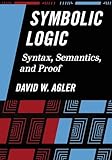Symbolic logic : syntax, semantics, and proof / David W. Agler.
Material type: TextLanguage: English Lanham, Md. : Rowman & Littlefield Publishers, 2013©2013 Description: 374 pages : illustrations ; 26 cmContent type: text Media type: unmediated Carrier type: volumeISBN: 9781442217416 (cloth)Subject(s): Logic, Modern | Logic, Symbolic and mathematicalLOC classification: BC38 .A35 2013Review: The author provides visually convincing examples that illustrate the concepts of symbolic logic effectively, a feature not commonly found in similar textbooks. The abundance of sample symbolizations and proofs in this book makes it ideal for classroom use. (Masato Ishida, University of Hawaii) Agler's Symbolic Logic: Syntax, Semantics, and Proof is a remarkably clear and systematic introduction to first-order formal logic. Notably, Agler does an excellent job in showing why we use these particular rules through multiple examples and step-by-step explanations of how they develop from general considerations of meaning and truth. This method of building up to the rules of symbolic logic will be incredibly helpful in improving student understanding, since it presents the formalism as something to be understood, rather than simply memorized. (Daniel Brunson, Morgan State University).--Back cover.
TextLanguage: English Lanham, Md. : Rowman & Littlefield Publishers, 2013©2013 Description: 374 pages : illustrations ; 26 cmContent type: text Media type: unmediated Carrier type: volumeISBN: 9781442217416 (cloth)Subject(s): Logic, Modern | Logic, Symbolic and mathematicalLOC classification: BC38 .A35 2013Review: The author provides visually convincing examples that illustrate the concepts of symbolic logic effectively, a feature not commonly found in similar textbooks. The abundance of sample symbolizations and proofs in this book makes it ideal for classroom use. (Masato Ishida, University of Hawaii) Agler's Symbolic Logic: Syntax, Semantics, and Proof is a remarkably clear and systematic introduction to first-order formal logic. Notably, Agler does an excellent job in showing why we use these particular rules through multiple examples and step-by-step explanations of how they develop from general considerations of meaning and truth. This method of building up to the rules of symbolic logic will be incredibly helpful in improving student understanding, since it presents the formalism as something to be understood, rather than simply memorized. (Daniel Brunson, Morgan State University).--Back cover.
| Item type | Current library | Shelving location | Call number | Copy number | Status | Date due | Barcode |
|---|---|---|---|---|---|---|---|
| Books | MEF Üniversitesi Kütüphanesi | Genel Koleksiyon | BC 38 .A35 2013 (Browse shelf (Opens below)) | Available | 0016252 |
Includes bibliographical references and index.
The author provides visually convincing examples that illustrate the concepts of symbolic logic effectively, a feature not commonly found in similar textbooks. The abundance of sample symbolizations and proofs in this book makes it ideal for classroom use. (Masato Ishida, University of Hawaii) Agler's Symbolic Logic: Syntax, Semantics, and Proof is a remarkably clear and systematic introduction to first-order formal logic. Notably, Agler does an excellent job in showing why we use these particular rules through multiple examples and step-by-step explanations of how they develop from general considerations of meaning and truth. This method of building up to the rules of symbolic logic will be incredibly helpful in improving student understanding, since it presents the formalism as something to be understood, rather than simply memorized. (Daniel Brunson, Morgan State University).--Back cover.
